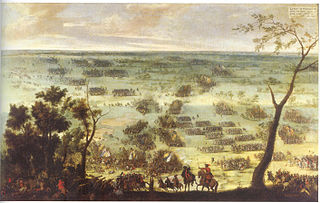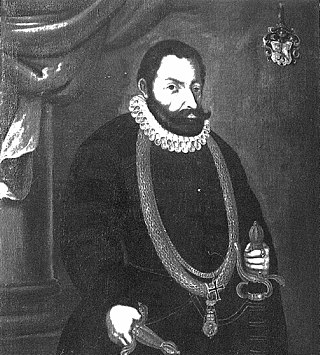
Johann Jakob von Bronckhorst (Burg Anholt, 12 February 1582 - Freiburg im Breisgau, 19 October 1630), named Graf Anholt, was Count of Bronckhorst-Batenburg and Imperial fieldmarshal during the Thirty Years' War.

Johann Jakob von Bronckhorst (Burg Anholt, 12 February 1582 - Freiburg im Breisgau, 19 October 1630), named Graf Anholt, was Count of Bronckhorst-Batenburg and Imperial fieldmarshal during the Thirty Years' War.
He was the second son of Jacob of Bronckhorst-Batenburg (1553–1582) and Gertrud of Myllendonk (1552–1612). He studied in Lorraine and did a Grand Tour of Italy. In 1603, like his father, he entered the Spanish army. After the Twelve Years' Truce in 1609, he became a colonel in the Austrian army. His commander Leopold V, Archduke of Austria, appointed him in his Geheimrat and made him commander of a Regiment. He fought in the Thirty Years' War in 1618, and also participated in the Battle of White Mountain in 1620. As a reward, he became count in 1621 and Field Marshal the following year.[ citation needed ]
In 1622/23 he fought in Westfalen against Christian von Braunschweig-Wolfenbüttel and Peter Ernst von Mansfeld, which he pushed back into East Frisia. He played an important role in the victory in the Battle of Stadtlohn, as commander of the vanguard.
In 1624 he participated in the Siege of Breda under Ambrosio Spinola, and fought later under Tilly in Osnabrück against the Danes. In the Winter of 1627/28 he took up winter quarters in East Frisia. In 1628 he became a Knight in the Order of the Golden Fleece, and in 1629 he became Governor of the Alsace and of Further Austria. In 1630 he died in Freiburg from tuberculosis.[ citation needed ]
Johann Jakob married on 6 November 1618 with Maria Cleopha von Hohenzollern-Sigmaringen, daughter of Charles II, Count of Hohenzollern-Sigmaringen and Elisabeth von Pallandt-Culemborg. They had 2 children:

Charles Eugène de Croÿ was a German and Russian Field Marshal and nobleman from the French noble House of Croÿ.

The Battle of Stadtlohn was fought on 6 August 1623 between the armies of the Electoral Palatinate and of the Catholic League during the Thirty Years' War. The League's forces were led by Johann Tserclaes, Count of Tilly, the Protestants by Christian of Brunswick. The battle resulted in a resounding Catholic victory that largely ended the military resistance of the Palatinate forces and thus marked the end of the first phase of the Thirty Years' War.

The House of Hornes was an old and important European noble family, which became extinct in the male line in 1826. The name refers to Horn, a small village in Limburg, located in the Netherlands.

Charles Theodore Otto, Prince of Salm, was Count of Salm-Salm since 1663 and Obersthofmeister at the Austrian Court.

Sigmaringen Castle was the princely castle and seat of government for the Princes of Hohenzollern-Sigmaringen. Situated in the Swabian Alb region of Baden-Württemberg, Germany, this castle dominates the skyline of the town of Sigmaringen. The castle was rebuilt following a fire in 1893, and only the towers of the earlier medieval fortress remain. Schloss Sigmaringen was a family estate of the Swabian Hohenzollern family, a cadet branch of the Hohenzollern family, from which the German Emperors and kings of Prussia came. During the closing months of World War II, Schloss Sigmaringen was briefly the seat of the Vichy French Government after France was liberated by the Allies. The castle and museums may be visited throughout the year, but only on guided tours. It is still owned by the Hohenzollern-Sigmaringen family, although they no longer reside there.

Charles II, Count of Hohenzollern-Sigmaringen(German: Karl II, Graf von Hohenzollern-Sigmaringen) became Count of Hohenzollern-Sigmaringen in 1576 and remained so until his death. He was the fifth but second surviving son of Charles I, Count of Hohenzollern, and Anna, daughter of Ernest, Margrave of Baden-Durlach.

Prince Johann Georg of Hohenzollern was a German prince, and through his marriage to Princess Birgitta of Sweden, was brother-in-law of King Carl XVI Gustaf of Sweden.
Karl Friedrich was a member of the House of Hohenzollern and Prince of Hohenzollern-Sigmaringen, Lord of Haigerloch and Wehrstein from 1769 until his death.
Johann Georg of Hohenzollern-Hechingen was the first Prince of Hohenzollern-Hechingen.

Prince Joseph Ernst Friedrich Karl Anton Meinrad of Hohenzollern-Sigmaringen was the fifth Prince of Hohenzollern-Sigmaringen. He ruled from 1715 to 1769.

Count Christoph of Hohenzollern-Haigerloch was the first Count of Hohenzollern-Haigerloch.

Prince Johann of Hohenzollern-Sigmaringen, was the ruling Count of Hohenzollern-Sigmaringen from 1606 to 1623. He was elevated to the rank of prince in 1623 and so was Prince of Hohenzollern-Sigmaringen from 1623 until his death.
Karl, Count of Hohenzollern-Haigerloch was the third Count of Hohenzollern-Haigerloch.

Meinrad I of Hohenzollern-Sigmaringen was Prince of Hohenzollern-Sigmaringen from 1638 until his death.
Johann Christoph, Count of Hohenzollern-Haigerloch was the second Count of Hohenzollern-Haigerloch.

The siege of Lochem also known as the Relief of Lochem was a siege that took place in the Dutch city of Lochem during the Eighty Years' War and the Anglo–Spanish War. The city was relieved by a States army composing of English and French Huguenot troops under Count Philip of Hohenlohe-Neuenstein and William Louis of Nassau-Dillenburg and John Norreys on September 24, 1582. This marked the end of the Spanish siege of the city by the Spanish general Francisco Verdugo.

Johann Fugger the Elder or Hans Fugger was a German businessman, landowner and noble of the Fugger family. He was Lord of Schloss Babenhausen and Boos.

Johann Eustach von Westernach was the 44th Grandmaster of the Teutonic Order, reigning from 1625 to 1627.